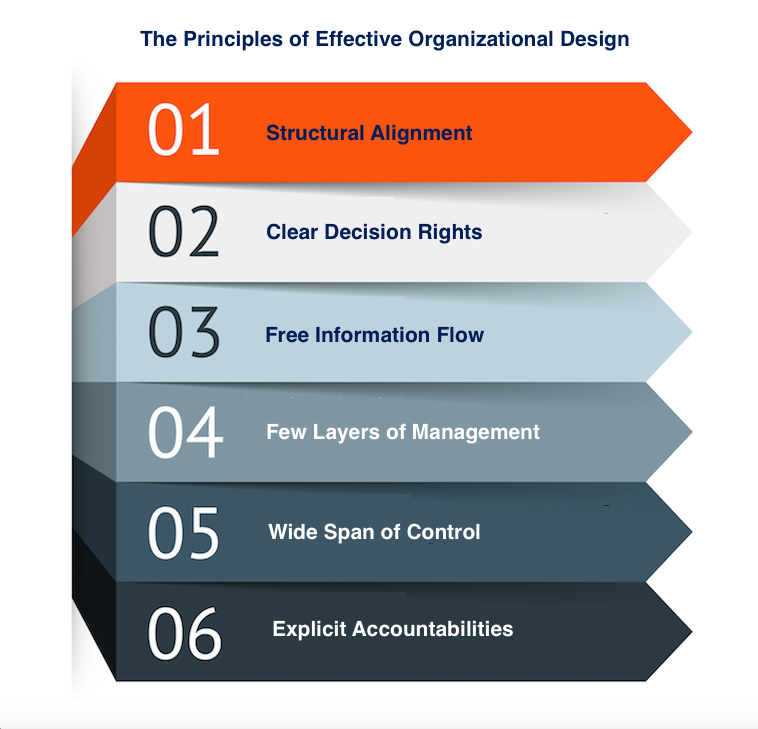Strategy execution requires the organization to align with the strategy. The reason is that execution is the collective result of thousands of decisions and actions by employees at the grass-root level. For the strategy to work, the employees need to fall in line with the strategy. Therefore, how they are organized in the work they do and the functions they carry out truly matters. Two questions will inform you on the issue: “Is our organization aligned to the strategy?” and “How do we know?” A quick way to answer these questions is to check for symptoms.
SYMPTOMS OF WEAK ORGANIZATIONAL DESIGN
Five types of symptoms signal that the organization does not align with the strategy. They touch on different sides of the organization but ultimately tell a common story.
Exhibit 1. Symptoms of Weak Organizational Design

A few questions can help inform whether any of these symptoms apply to your organization.
1. Poor Strategic Fit
– Is the strategy being implemented as intended?
– Is the strategy execution taking longer than scheduled?
– How well are the strategic initiatives being executed relative to the plan?
– Can you trust the strategy execution process to deliver the strategy?
2. Inadequate Market Coverage
– Is the company missing market opportunities?
– Is the company able to devote adequate attention to markets, customers, or geographic
segments as planned?
– If not, why not?
3. Escalating Organizational Costs
– Is the business experiencing an increase in administrative costs?
– Has the cost of coordination across divisions been increasing?
– How have overhead costs been behaving?
– Do overhead functions appear under-resourced/over-stressed?
4. Low-Quality Decision Making
– Is decision-making in line with the strategy?
– Do decisions take a long time to make?
– Are decisions that should be made at one level constantly being referred upward?
5. Poor Internal Climate
– Do the organization and its people appear stressed?
– Is the organization experiencing low morale? Internal conflict?
– Is the business operating in a state of crisis management?
– Is management constantly putting out fires?
Anyone of these symptoms tells you that the organizational design is not working in your favor. Something is not working right. In some cases, your business may be experiencing more than one symptom, which indicates that the organization may be overloaded and coming under stress. If that is where you are, then the question becomes “How long can the business continue to operate this way?”
WHAT MAKES FOR EFFECTIVE ORGANIZATIONAL DESIGN
What makes for organizational effectiveness is a lean structure that follows the strategy. For that to happen, the design of the organization must embody key elements that link to the strategy and each other. The pursuit of organizational effectiveness does not have to be a nebulous concept. The starting point of effective organizational design is a set of well-understood principles used regularly by the best companies to produce a high-performance organizations.
Exhibit 2. The Principles of Effective Organizational Design

THE BENEFITS OF ORGANIZATIONAL EFFECTIVENESS
It is useful to gauge the effectiveness of the organization from time to time if nothing else as an act of preventive maintenance. The main reason is that poor organizational alignment can be a hidden obstacle to strategy execution, and usually goes undetected.
Common business initiatives such as the addition of new product lines, expansion into new geographic markets, the creation of new divisions, integration of mergers or bolt-on acquisitions, and many others, impact the design of the organization. If left unchecked, their effect can become sizable over time to the point of straining the organization. Therefore, reviewing the organizational design for alignment is good practice.
Beyond that, as a company gets ready to implement a new strategy, corporate staff groups, operating units and geographically dispersed units need to be able to work together. At such a time, assessing the organization’s alignment with the new strategy becomes essential. Not only will the organizational assessment disclose issues of strategic fit, but it will also determine the time within which implementation must be accomplished. So get the organizational design right, and the strategy will be more likely to succeed.

